#Micom BASIC Magazine
Text
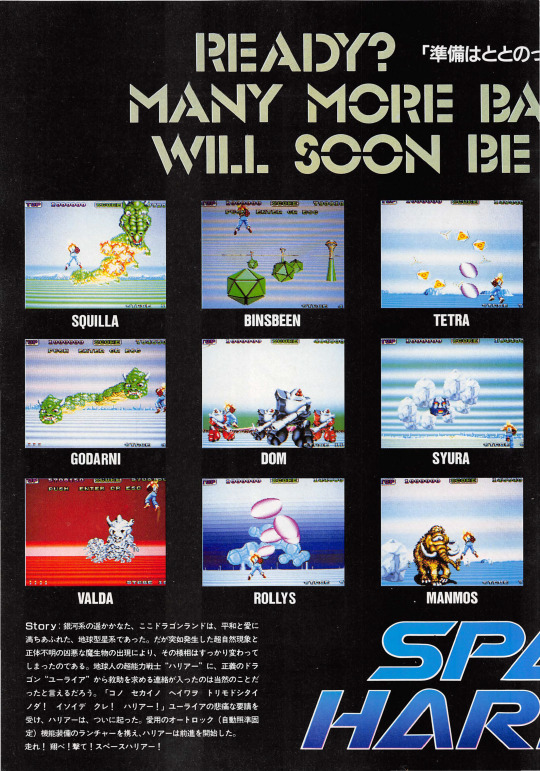

Space Harrier (X68000 vers.) - Micom BASIC Magazine, 1988 issue 1
9 notes
·
View notes
Text
Serious Play, Sincere Review - Target 11: Paving the Way for Japanese games on western PCs
Originally written in Japanese by Akira Yamashita for the July 1989 issue of Micom BASIC Magazine
Currently Japanese video games are highly regarded around the world. If you go to a video arcade in the United States, 9 out of every 10 cabinet will contain a so-called "overseas version" of a video game originally developed in Japan. Moreover, the Nintendo Entertainment System (or NES) has been conquering the nation for over a year. Famicom games that were already popular in Japan have been gradually ported over to the NES and achieved great success in the States as well. It seems the word "Nintendo" has entered the vernacular of American children as a word that represents a form of entertainment. By contrast, Japanese developed PC games haven't been making much of a splash overseas in the same way that their arcade and NES counterparts have done. But lately they are suddenly starting to get attention, as many ports are now being released. This month we tried shining a spotlight on these Japanese games that paving the ways on the foreign market.
Japanese Games From Sierra
Sierra On-Line is headquartered on the west coast of the United States, in a small town located on the outskirts of California. With around 200 employees, Sierra is among the top five software houses in the United States, with their titles always dominating the top ten best-selling charts.
If you've been playing adventure games for a while now, perhaps you might had heard of the name Sierra at least once. They were the great company that made the original versions of several adventure games, such as Mystery House and Wizard & The Princess, that were released in Japan by Starcraft. It is well-known that these games, which were part of the so-called "Hi-Res Adventure" series, were the first adventure games to feature graphical screens and were very popular even in the States.
Their latest line of games, the King's Quest series, have also attracted a lot of attention, becoming a big hit with over a million units sold. They're adventure games that are a bit different from the rest, in which the player types in a command on the keyboard and the on-screen character will act accordingly.
For example, in the fourth entry of the series, The Perils of Rosella, if you type the command "clean room" after the heroine has entered an unclean room, it will trigger an event in which she will fix each of the beds, takes a broom out of the shelf and starts sweeping the floor, gathers all the dishes scattered on the kitchen table and then washes them on the sink. The animation is quite detailed too.
What sets this apart from a usual Japanese game is that such a scene in the game exists not necessarily to have the player progress through the story, but simply to entertain. The King's Quest games employ a score system in which the amount of points a player has increases for each event that they managed to do. However, the game can still be completed, even if the player's score is low. This means that there's no pushy obligation for the player to watch all the scenes in the game, which is good. The more you play, the more discoveries you make that makes the game's world feel deeper. Sierra On-Line calls this kind of game a "3-D Animated Adventure Game."
When we learned that such a company that has been leading the computer game software industry in both, the past and present, has been porting and publishing Game Arts titles in the United States under their own brand, we immediately went to the company's Japanese subsidiary, Sierra On-Line Japan. to get to the story.
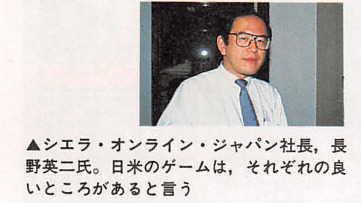
"When it comes to Japanese arcade games, particularly in the action genre, our staff recognize their tremendous quality and how much they have evolved. Our staff, starting with our company's president, would repeatedly visit Japan to research our country's games and study their market, and it was during one of such visits that they encountered a game titled Thexder running on the NEC PC-8801 Mk. II SR. They felt in love on first sight and immediately went to Game Arts to negotiate for the license and that's how we ended up introducing the game to the IBM PC." says Eiji Nagano, President of Sierra On-Line Japan.
Two of Games Arts' titles have already been converted and published by Sierra On-Line. Both titles have been selling relatively well, with Thexder, released on August 1988, moving 200,000 units, while Silpheed, released on April 1989, has moved 35,000 units a month after its release.
I was curious about the quality of these ports, so I tried them out on the spot and I was surprised at how good they turned out.
Starting with Thexder, the explosion patterns were not included due to hardware limitations and the music is now rendered in beeps, but other than that, I found almost no difference with the original PC-8801 version. I've been told there are many hardcore Thexder players in the United States, with some mighty players having even achieved a score of 10 million points.
As for Silpheed, there is no doubt that it holds up quite well compared to its PC-8801 counterpart. Aside from the fact that it's a bit slower, its MIDI-generated soundtrack is, in a single word, amazing. I played the game using a Roland MT-32 sound module and I was deeply moved by the breadth of its sound. Perhaps there aren't that many people experienced with the MIDI music format, but if you play this game, you will certainly be captivated by it. It seriously made me wish that more Japanese game developers would support the MIDI format.
I went on asking Mr. Nagano how they managed to put out such faithful conversions with high-degree of accuracy.
"The conversions of both of these titles were handled by American programmers. Immediately after the contract was signed, a programmer would be sent to Game Arts to stay for around a week and they would be given technical guidance with detailed instructions. Since there isn't that much of a difference between Japanese and American programmers in terms of technical skills to begin with, it's simply a matter of mastering the proper know-how quickly. Perhaps the most difficult part is the fact that the comments on the source code are written in Japanese. But even I, as someone who was involved with the conversion process, was surprised at what they achieved."
It appears that Sierra On-Line plans on converting more Japanese titles to western machines at a pace of two titles a year. Their conversion of Sorcerian, which is currently under development, is scheduled to be released this December.
In contrast, Sierra On-Line Japan is also planning on releasing several of its own original games to Japanese PCs. Just the thought of being able to play a King's Quest game on the NEC PC-9801 is enough to make me excited.
However, the accuracy of the conversion could be an issue. Everyone knows that factors such as disk access and screen loading times are great factors in affecting a player's motivation. Since the original versions are great games, I hope that any conversion could be just as good as the Silpheed port.
Mr. Nagano has this to say on the matter.
"When it comes to porting software between Japan and the United States, there must be adjustments made to suit each country's climate and characteristics. For example, it must be said that getting a Japanese person to comprehend dry American humor can be quite a difficult task. Knowing how to adapt that is the key."
To become a software exchange base between the United States and Japan. Sierra On-Line Japan has become an interesting place.
Report of Japanese Games in the United States Part 1
John Williams, a representative of Sierra On-Line, writes
"Japanese video games are quite popular in the United States thanks to their unique atmosphere. But if I'll be frank, when it comes to [Japanese] PC game publishers, it must be said that they're struggling quite a bit.
For example, when it comes to the U.S. market, I think the Japanese company with the biggest share is Taito, but they don't quite stack up to Nintendo, even if they seem to be doing well porting their own arcade titles.
Koei is also praised by magazines for their historical simulation games, but they aren't available in many formats, so they're unlikely to have a hit at this point.
When you keep that in mind, our company's Thexder is a Japanese-developed PC game that did quite well. I'm sure Silpheed will also become a hit like Thexder. However, I don't think it will be a tremendous hit due to the current overwhelming popularity of Nintendo in the United States.
But we'll do our best. Silpheed will be the proof that the Nintendo is not necessarily the perfect game machine. It's a splendid game. I'm sure everyone will appreciate the MIDI compatibility as well."
Japanese Games From Kyodai
Kyodai Software Marketing, with its unusual name, was founded last spring as a joint venture between Broderbund Software and 11 Japanese PC software houses. Their offices are located in San Rafael, California, which is north of San Francisco. I can't helped but be surprised by their first lineup, which includes Ys, Murder Club, Hydlide III and Curse of Babylon, because it's quite extravagant.
The following is the full list of companies participating in Kyodai
Broderbund
Hummingbird
T&E Soft
Pony Canyon
Kogado Studios
Xtalsoft
Game Arts
Telenet Japan
Nihon Falcom
BPS
Micro Cabin
Riverhill Soft
Mr. Tsumura, the President of Kyodai, explained to us the reason for the company's formation via an international phone call.
"When it comes to games that were ported over from the United States to Japan, there aren't that many that ended up becoming hits. However, when you look at the arcade and Nintendo markets, in other words, Japanese games that were converted to the United States, it's been a great success. Therefore we turned our attention towards Japanese PC games, which have yet to reach the U.S. market in any significant way. Within that background we couldn't overlook the matching needs between the Japanese software houses who were seeking business opportunities in the foreign market, and Broderbund Software, who wanted to handle Japanese software with their own distribution channel."
The selection process on which games to port over was started immediately after Kyodai was established. Naturally the criteria of choosing a game was based on what suits the American market, but the way they handled it is quite interesting.
"We started by creating three evaluation teams comprised of Americans. They're very different from each other, with one team being comprised of business people, the second of high school and college students who are enthusiasts, and the third one of people who don't know much. We then have them play a game on a Japanese computer, whether it's a PC-8801, PC-9801 or an MSX, and gauge their reactions. Naturally we have an interpreter on their side to help them out. For our current lineup, we picked games that were popular with all three teams."
Unfortunately I was unable to look at any screenshots of the ports themselves, but the company aims on releasing all four titles within the year and are developing them at a rapid pace. I asked Mr. [Tokihiro] Naito from T&E Soft, who have apparently seen a sample version of the Hydlide III port, on his thoughts on it.
"The resolution of the [western] machine is half of the Japanese PC, so it was a bit painful to some extent, but they still did a pretty good job. The arrangements that gave me a sense of the American programmer's sensibilities were quite interesting. For example, the trees on the plain were moving in a noisily matter and the hero's weapon could be fired rapidly with somewhere up to 6 to 9 shots on-screen (as opposed to the 3 shots on the original version). As the programmer for the original version, I'm hoping that the port doesn't completely loses the sense of the game."
During my conversation with Mr. Naito, I could get a glance of the difference in the national characteristics of a Japanese player and an American player. When pondering on what makes a game a hit in Japan and in the United States, it's a factor that can't be ignored. American players are likely to think about a puzzle for months, no matter how absurd it might be, while Japanese players will likely drop a game if they get stuck even if it was only for a bit. On the other hand, Americans like games where they mindlessly shoot things, while the Japanese like games such as the Tower of Druaga, in which knowledge is important.
In the end, can a Japanese PC game overcome such difference in national characteristics and truly become an international hit. Mr. Tsumura calmly analyzed that in the following matter.
"Americans as a race are, by their very nature, rich when it comes to their imagination. They have the ability to enter a game's world and immerse themselves into a role without much explanation needed. Therefore, most American games, if I have to say, are rather simple in terms of graphics and we're created to stimulate the imagination of the player. In contrast, Japanese games are neatly designed from the start, with good graphics and a good story. When it comes to Americans, I don't see any reason why they would dislike such a game. If we can built a brand image that says 'this is what Japanese PC games are like', then we would have more than sufficient capability to create hits."
Mr. Tsumura continued explaining his aspirations for Kyodai.
"Ultimately I want Japanese software houses to start producing games for the American market from the get-go and release them under the Kyodai brand. For that purpose we intend to gradually provide information about the American market to Japanese developers. To everyone in Japan, if you have anything you want to learn, contact us without hesitation We will keep working like we were representatives of Japan, so please support us."
Kyodai's Release Lineup
Murder Club (by Riverhill Soft) - The first installment in the J.B. Harold series. A detective-themed adventure that uses a menu-driven system, it was praised for its beautiful graphics. There were perhaps many people who were moved by the amazing visuals of the recently-released Sharp X68000 version. Can the U.S. port achieve the same quality of graphics? And will they also include the investigative journal?
The Ancient Land of Ys (by Nihon Falcom) - An active RPG with a user-friendly design that allows any mystery to be simplified enough to be solved by anyone. We're particularly curious if the United States could be receptive of this kind of game.
Hydlide III (by T&E Soft) - An active RPG that implements features such as a notion of time and a carrying limit. The objective of the game is to defeat the dark ruler Gaizack in order to bring back peace to Fairyland. Since the original version already included an English language mode, a conversion should be simple.
Curse of Babylon (by XTALSOFT) - A somewhat unsual active RPG played from a side-view perspective, but uses a bum-rush system. The game's option to freely choose your background music was much talked about. It was also known for its very large map. Taking a look at this, it seems that most of the games being ported are Active RPGs.
Report on Japanese Games in the United States Part 2
Akira Hibiki, Micom BASIC Magazine's U.S. correspondent, writes:
"When it comes to arcade games, the Pac-Man series, along with Final Lap and Operation Thunderbolt are all popular in the video arcades around my area. Tetris also seems to be popular here, but it's a version of the game developed by Atari [as opposed to the Sega version that was released in Japan]. Surprisingly Gradius doesn't seem to be very popular here. Seeing a black person credit-feeding his way through Splatterhouse until getting to the end made me smile.
As for the NES, Japanese games are overwhelmingly popular. The Legend of Zelda and The Adventure of Link are always selling out in stores, so they're pretty hard games to obtain. However, most kids don't seem to be aware of their Japanese origins. With that said, a game magazine here ranked Zaxxon No.1 in popularity. I suspect there must have some secret way to enjoy that game.
As for Japanese-developed PC games, unfortunately they don't seem to be that well-known, if at all."
In Conclusion
When thinking about it, there has been many things that Japanese PC games had learned from American games. The most obvious example being the RPG genre. Many types of RPGs have been born by using the systems of two great series, Ultima and Wizardry, as a foundation and then adding several flavors of originality. And there's no mistake that this is a development that will continue in the future.
The debt that Japanese games have receive from the United States is truly immeasurable. But now that the environment has been set up to allow Japanese PC games to enter the market, perhaps it's time to return the favor. It's difficult to know whether a game that was a hit in Japan could also be a hit in the United States or not. Perhaps a game that didn't do well in Japan might capture the hearts of Americans. At any rate, if a Japanese-produced PC game can make an American game player or developer feel something, then I would be really glad as someone who participates in this industry.
Advancing into the foreign will be one of the big challenges that must be faced when it comes to Japanese-made PC games.
13 notes
·
View notes
Text
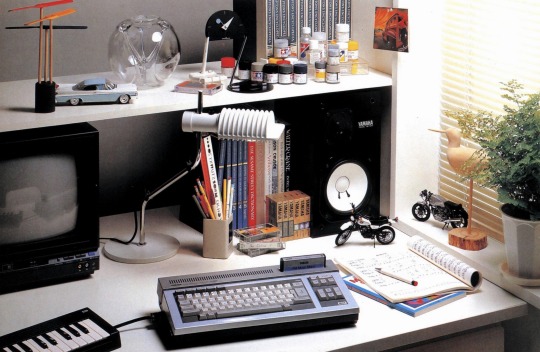
Micom BASIC Magazine (1984)
651 notes
·
View notes
Text
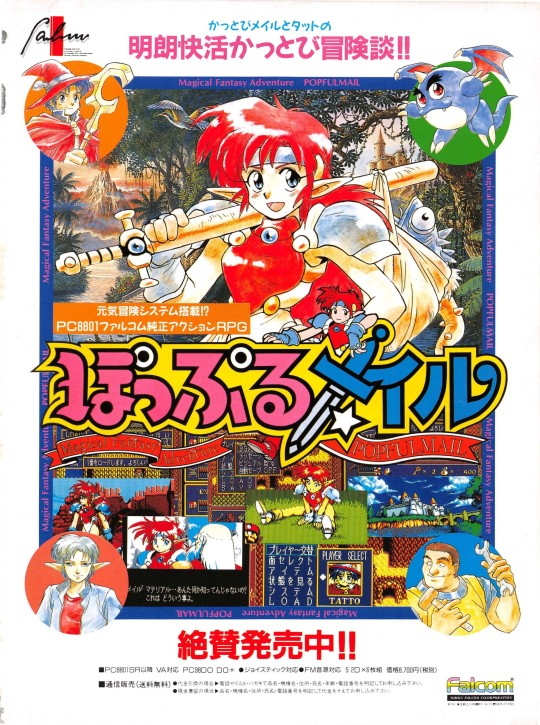


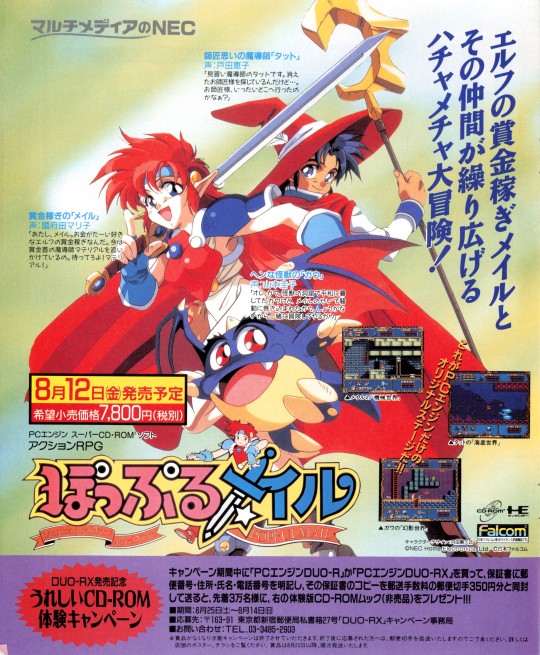
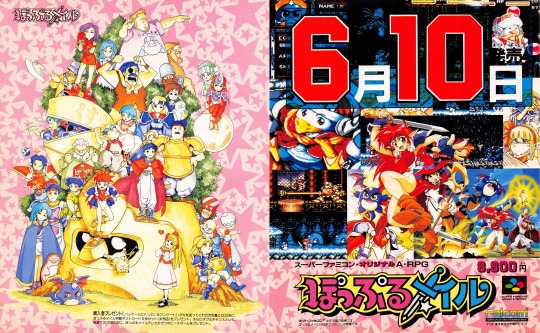
Magazine advertisements for the many different iterations of Nihon Falcom's Popful Mail (PC-88, Mega CD, Super Famicom, and PC Engine CD).
Sources are: Micom BASIC March 1992, Micom BASIC January 1992, Micom BASIC April 1994, PC Engine Fan August 1994, and Dengeki Super Famicom June 17, 1994.
252 notes
·
View notes
Text
[incomplete] Unofficial miscellaneous Mayura trivia
What is the meaning of the ‘Wiz’ in ‘Nanika Wiz Mayura’?
Nanika with (ghost name) was a common format for ghost titles, starting with Sakura/Nin-i-tan
A tribute and clever pun to the legendary Wizardry series - a series of role-playing video games, developed by Sir-Tech, that were highly influential in the evolution of modern role-playing video games. The original Wizardry (released in 1981)was a significant influence on early console role-playing games such as Final Fantasy and Dragon Quest. Originally made for the Apple II, the games were later ported to other platforms.
Wizardry IV: The Return of Werdna, released by Sir-Tech in 1987, is famously the hardest game in the history of computer RPGs. There is nothing harder. The majority of those who have played it were unable to leave the very first room. It’s like the ancient blueprint of the RPGs we know and love today.
I find it a groundbreaking feat that the game was re-programmed from scratch and is somewhat playable within Mayura’s dialogue, despite being an English game this is the biggest obstacle to translate for me.
Wizardry has recently opened an official english site for the first time to promote the remake, you can see the history of it there
-----------------------------------------------------------------------------
help, I don't understand Mayura's references!
That's okay, me neither when it comes to many of them.
many of her references stem from a magazine called Micom BASIC(マイコン BASIC), one of the oldest running gaming magazines focusing on microcomputers.
up until as recently as 2022 it was near impossible to find any archives of Micom BASIC, but you can check out some scans of them (untranslated) here:
https://retrocdn.net/Category:Micom_BASIC_scans
https://archive.org/details/micomBASIC19841994
also highly recommend this translator's blog if this sort of stuff interests you - @thearkhound they've made some really accurate and insightful english translations of never before seen interviews with legendary game devs like Shigeru Miyamoto from Micom BASIC.
-----------------------------------------------------------------------------
but as someone who struggles with having the attention span to complete classic RPGs (many being obscure, japan release only and too expensive on the second hand market as well) it's helped me immensely to casually watch Gamecenter CX and the Wizardry OVA to get a better grasp of some of the terms and spells she uses.
-----------------------------------------------------------------------------
SA-GCCX English Subtitled Downloads and Information:
------------------------------------------------------------------------------
Wizardry OAV (1991):
youtube
Some versions of your translation differ with what club Mayura is the president of, what’s the deal with that? Which club is she the president of?
To be honest it’s hard to say because she changes the answer every time, but there is a part of Mayura’s script as well as a little javascript code on her now defunct official blog which randomly generates a club title, picking from various retro gaming keywords, before twitter’s API was destroyed there was a widget where you could hit 'join club' by sharing it to a Twitter hashtag. from what I can gather She’s formed a whole lot of gaming clubs and is simultaneously leading all of them at once.
How come Mayura identifies as both a wizard and a girl? (or ‘Why is she a Digital Witch?’)
(a few explanations for this but TLDR; there’s a ton of inconsistencies spanning my various translations of Mukei’s homepage, it seems like wizard and witch are interchangeable in retro RPGS, sorry if it’s confusing)
During the earliest days of RPGs ( especially J-RPGS from the years 1982-1987), Wizard was usually a gender neutral or unisex character class.

Native Japanese speakers say “mahoutsukai” normally to mean ‘wizard’ in Japanese. mahoutsukai – 魔法使い (まほうつかい) : a noun meaning ‘wizard’ in Japanese. This can also work as plural. Depending on the context and situation, this can also mean ‘witch’ in Japanese.
The Japanese kanji for ‘wizard’ is Mahou Tsukai, which is directly ‘Magic user’ and does not specify a gender, Mayura’s favourite game (and ghost namesake) is Wizardry and a majority of her personality and dialogue is based around it, so it felt fitting to translate it to Wizard.
“Witch”/”Digital Witch” and “Wizard” are used in english interchangeably in (untranslated) 2010s iteration of Mayura’s blog so I'd say it's probably up to personal preference, both are correct
in the history of programming, Structure and Interpretation of Computer Programs (SICP) is a computer science textbook by Massachusetts Institute of Technology professors Harold Abelson and Gerald Jay Sussman with Julie Sussman. It is known as the "Wizard Book" in hacker culture and refers to programming or hacking as magic, using sorcerer's spells to invoke the processes within the machine . (which I'm too uneducated to fully understand but my reasoning is that wizards = hacker and technology related)
Why does Mayura speak so strangely?
Her only knowledge of human culture or the 21st century is learnt solely through archaic RPGs and reading through strategy guides or obscure out of print magazines like Micom BASIC. According to her extended lore, 400 years ago she was a human living in the real world, but she was an orphan and the village she lived in shunned her and tried to burn her at the stake. it's said in some of the Mayura Maniacs reference sheets that before her current life as a desktop buddy, she was an orphan and an alchemist named Unyx took her in as his student, protecting her and teaching her to control her magic powers. in order to save her from being executed, he had to transmute her soul into a 6-pointed star bracelet. Mayura was 20 years old at that time and lost all memory of her previous life when she was re-awakened in the 20th century and many of her favorite games were released in the founding years of gaming before my time during the 80s and 90s
15 notes
·
View notes
Photo

‘Klax - ‘Karen’’
[LYNX] [JAPAN] [MAGAZINE] [1990]
Wow! Lynx Klax is an absolute replica of the original coin-op, with prefect graphics and even more perfect speech!
It's a strange sort of arcade puzzle game in which tiles of different colours roll down the screen on a conveyor belt and you've got to pick them up and drop them into a bin at the bottom of the screen in an attempt to make "klaxes” - lines of three similarly-coloured tiles, either horizontally, vertically or diagonally.
If a complete line is made, all the tiles disappear and the rest of the tiles fall downwards. If you fail to reach a set number of klaxes before the bin fills up with tiles it's game over. The game also ends if you let three tiles drop off the edge of the conveyor belt. If you think that sounds dull, think again. The game is simple, but very, very addictive indeed. It's got a variety of starting options, and there's much to discover - it's possible to score 260.000 on one drop (but we're not telling you how)! Highly recommended - it's the best Lynx game yet! ~Computer and Video Games, January 1991 (#110)
Source: Micom BASIC, July 1990 || MobyGames; Roberth Martinez
113 notes
·
View notes
Text


Space Harrier (PC-88 and X1 vers.) - Micom BASIC Magazine, 1988 issue 8
4 notes
·
View notes
Text


Sharp X1 Turbo Z II - Micom BASIC Magazine, 1988 issue 1
3 notes
·
View notes
Text

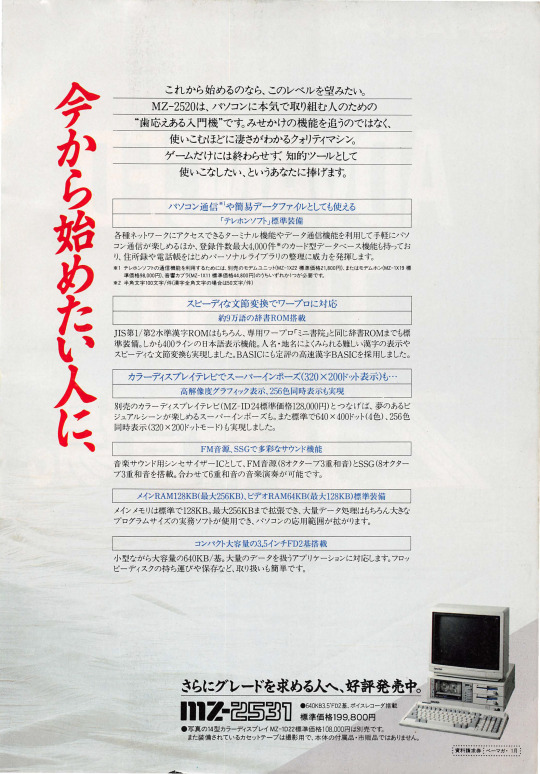
Sharp MZ-2520 - Micom BASIC magazine, 1988 issue 1
4 notes
·
View notes
Text

Space Harrier (PC Engine vers.) - Micom BASIC Magazine, 1989 issue 1
2 notes
·
View notes
Text


NEC PC-98DO+ - Micom BASIC Magazine, 1990 issue 12
3 notes
·
View notes
Text

A cute illustration showing the results to a Falcom character popularity poll. This was featured in the February 1995 issue of Micom BASIC, inside the magazine's monthly "Falcom News Express" column. My guess is that the art was drawn by Minako Iwasaki.
The results of the poll are:
Lilia (Ys)
Adol (Ys)
Mail (Popful Mail)
Christina (The Legend of Heroes III)
195 notes
·
View notes
Text
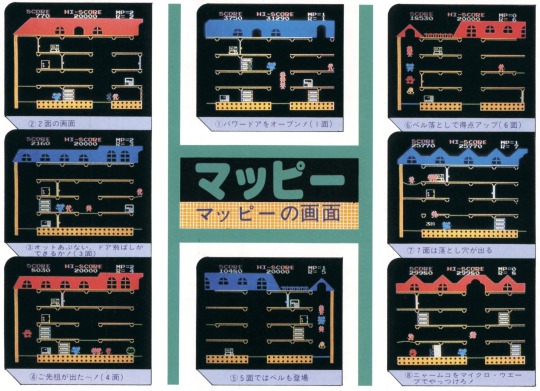
Micom BASIC Magazine (1984)
17 notes
·
View notes
Text
Metro Cross story manga and development team interview
Read from right to left.
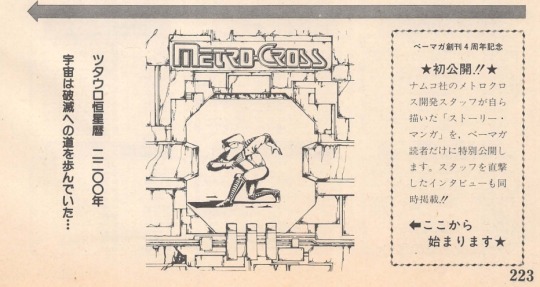
Micom BASIC 4th Anniversary Special
*First Unveiling!!*
Exclusively to readers of Micom BASIC, we’ll be unveiling a manga drawn by the developers of Metro-Cross themselves. There’s also a direct interview with the developers themselves.
“In the year 2200 of the Tsutauro Star Calendar, the universe was walking a path of destruction...”
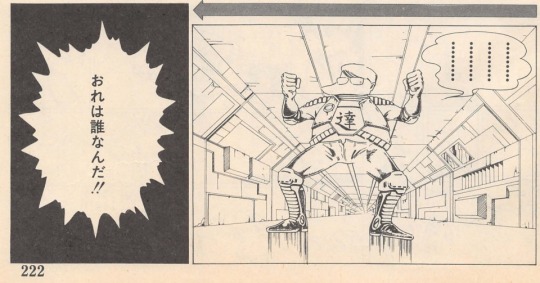
“....”
“WHO THE HELL AM I!?”

″DAMMIT! I can’t remember a thing.”
“And where am I?”
“This long corridor...”
“Am I inside some large structure? Or is this the insides of a spaceship?”
“I don’t know...”
“Why can’t I remember a thing?”
“WHAT THE HELL IS GOING HERE!”
DOKAN!
“Uhh”
ZUZUZU....
ZUZU...
BARIBARI
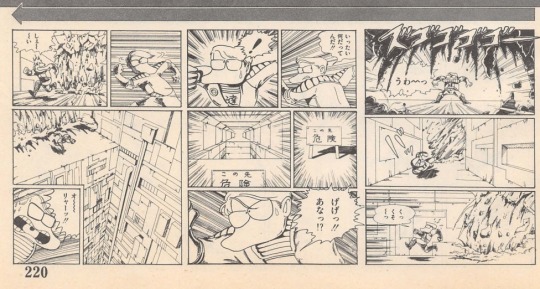
ZUGOGOGO
“Whoa!”
BATSU
“DAMMIT!”
“What the hell just happened?”
Sign: “Danger Ahead!”
“Oh great! A hole!!”
“YIKES!”
“HERE I GO!”

DOZU!
URGH
“D-dammit!”
“OH CRAP!”
“Heave”
“Ho”
“Heave”
“I thought I was a goner...”
PITSU
“Whoa!”
GARAGARA

″WAH!”
Game Over
“Jeesh...”
“Somehow I’m not dead yet!”
“This is yet another corridor.”
ZUGOGOGO
“Wut!”
“They don’t know when to give up!”
“How long must I keep on running like this?”
“An exit!”
“That’s right! I must find one!”
“That is...”
"If there is an exit...”
“But first and foremost is where am I...”
“I still don’t know.”
“Ah!”
“Something’s coming.”
GOROGORO!

GORON GORON
“The hell!”
“I NEED TO DO SOMETHING!!”
“HA!”
“JUMP!!”
TAN
“HOH”
“ARAYO!”
“Phew!”
“Piece of cake.”
“WHOA!”
“ANOTHER ONE!!”
DAWARAN DAWARAN
“HIAH!”
GOON!
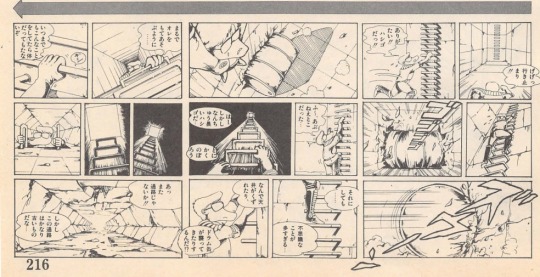
"GUH! A DEAD END!”
“Thank goodness! A ladder!”
GOGOGO
ZUUUN
“Phew... That was a close call.”
“This quite a long ladder.”
“But I have no choice but to climb it.”
“More importantly...”
“Many strange things have been happening...”
“What if the ceiling crumbles on me?”
“Or I get attacked by more oildrums?”
“Oh! It’s just another corridor!”
“But this one looks all deteriorated.”

"What an awful waste...”
″Atta!”
Zubu
“What the hell is this?
PERO
“Ah”
“Someone’s coming!”
“Maybe they’ll help me!”
“OVER HERE!”
“Thank goodness!”
“Maybe they know the exit.”
“Hey!”
“The hell...?”
GUWA!
“Whoa Whoat!”
“OH CRAP!”
“!”
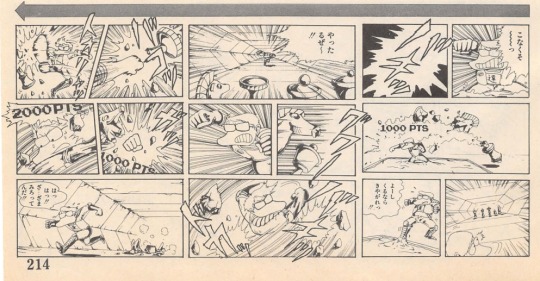
"YOU SHIHEAD!”
“BAKIH!”
“Alright! If they’re going to come, they’re regret it!”
“BRING IT ON!”
GUWA
BAKI
DOKAH
BAKO
TORIKATSU
GATSU
“Heh... Serves you guys right!”
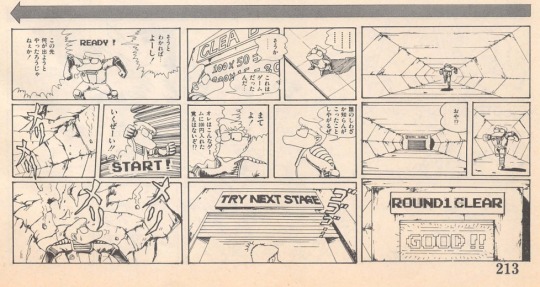
“Oy!?”
“....”
“I see...”
“So this was a video game all along.”
“I don’t know who is behind this, but I’m gonna move on.”
“Wait a minute!”
“I don’t remember putting a quarter in this kind of game!”
"If that’s the case, then alright!”
“I’ll keep moving forward regardless of what may come!”
“LET GO!”
MERI MERI
MERI MERI

BAKO MERI MERI GAJIN
BARIN
“WHOA!”
MERI MERI
“HELP ME!”
WAH!”
GASP!
“It was just a dream”
Huh.”
“My life expectancy was just reduced by ten years”
Yawn
“Well then!”
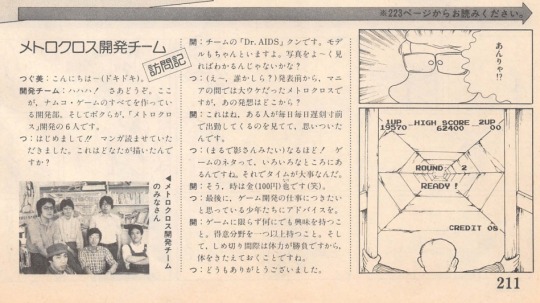
"I’ll be damned!”
ROUND 2 READY!
Visit to the Metro-Cross Development Team
Tsugumi: Good day!
Developers: Hello! Help yourself! This is the development department where all of Namco’s games are made. The six of us were involved with Metro-Cross.
T: It’s a pleasure to meet you! Thanks for sharing the comic. Which of you was the artist?
D: It was our team’s very own Dr. Aids. He also served as the model of the character. Perhaps if you look closely at the picture you might tell.
T: (Which of these guys is he?) Metro-Cross was a big hit among enthusiasts before the announcement, but where did the idea come?
D: There was this guy we saw everyday running to avoid getting late to work and that’s where we got the idea for the game.
T: (Sounds like Mr. Kage.) I see! It seems you can get a game idea from all sorts of places. Also, time is very important.
D: That’s right! Time costs a hundred yen [or a U.S. quarter]. (laughs)
T: Lastly, any advice you might give to children thinking about working on game development.
D: Have interests in many things, not just games. Have more than one thing to specialize at. And finally, keep yourself at good shape if you don’t want to lose a deadline.
T: Thank you very much!
Source: Micom BASIC Magazine July 1985 issue
4 notes
·
View notes
